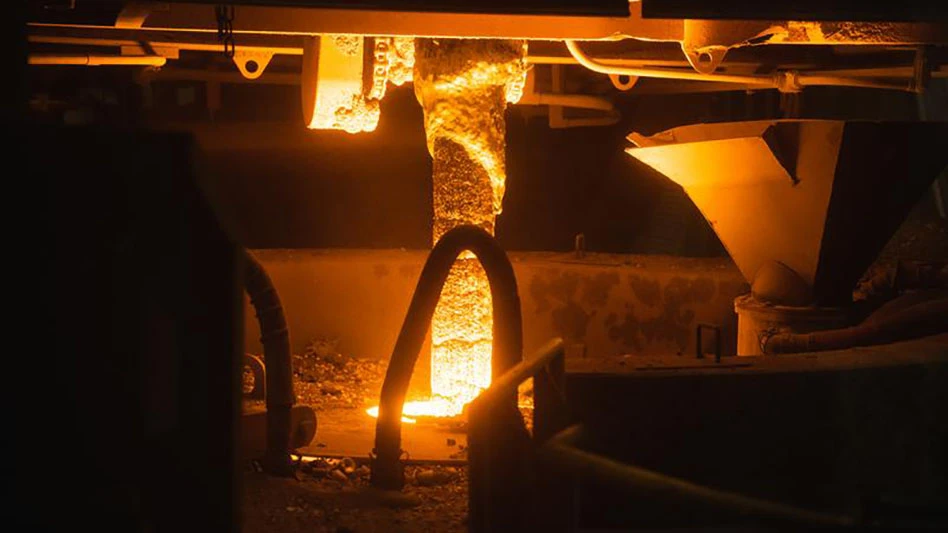Located in Milton Keynes, the newest city established in the United Kingdom – which resembles a United States suburb more than most British cities – is the largest material recovery facility in Britain. Opened last year, the facility is based on a U.S. model.
“Milton Keynes has one of the first curbside schemes in the U.K., which services all borough households,” says Gill King, recycling officer for the Borough of Milton Keynes.
The 50,000-square-foot building is located on seven acres, and serves a population of 200,000, according to King. The facility and land are owned by the Milton Keynes Borough Council, and the MRF is operated by a nonprofit company, the Community Recycling Opportunities Programme (CROP). Because curbside recycling is relatively new in the U.K., CROP was one of the few organizations with the experience to provide recycling services.
“Milton Keynes has provided curbside collection since 1990,” King explains. “At first, the material was processed on CROP’s premises, but these proved too small.”
Plans to build the MRF began in late 1990, but construction did not begin until late 1992, she says. Funding came from a combination of local sources. It took £6.5 million (about U.S. $10.01 million) to build the facility, and the borough’s first goal is to cover operating costs through material revenues.
“The building is the second largest investment the council has ever made,” says King. “The first was its town hall. In Milton Keynes, there are no old buildings you can convert, so you have to build from scratch.”
NUTS & BOLTS
Milton Keynes has a very similar curbside program to many in the U.S., says King.
“Recyclables are collected the same day as refuse, with corrugated cardboard, textiles and paper set out in a red box and glass, cans, plastic bottles, aluminum foil, drinks cartons, polystyrene and polypropylene set out in a blue box,” she explains. “We use a vehicle with 16 compartments.”
The borough has a total of 10 collection vehicles, each with a driver and three crew members, says King. The facility handles 42,000 metric tons per year, all source-separated and relatively clean. Of this total, 10,000 metric tons is materials collected at curbside from Milton Keynes, 21,000 metric tons is commercial materials, and the rest is from other local authorities.
“We are able to pay other boroughs for their materials,” says King. But even with this additional material, the facility is not likely to reach its total capacity of 100,000 metric tons per year any time soon, she adds. “To do so, we would be running 24 hours a day, seven days a week, and nobody in the U.K. is operating that much.”
After collection, the recyclables are brought to the MRF, where the majority of materials are unloaded onto the tipping floor, and then sorted and processed. In addition, seven bays behind the MRF hold materials that never reach the inside of the building. Three contain the different colors of glass, and the rest are reserved for white goods collected by the Council’s free special collection service. These appliances are stored until the chlorofluorocarbons can be removed and recycled, and then the metal is sold for scrap. Glass is sent to a glass cleaning plant to be processed and sold to one of the U.K.’s large cullet consumers.
The MRF’s tipping floor has two areas, one for paper and OCC and one for commingled containers. Each is fed through a conveyor to the interior of the plant, where a series of mechanical and manual sorting takes place and materials are processed and marketed.
Old newspapers and old magazines are bulked up and sold. “Mills prefer loose newspapers in Britain, unless they are stockpiling, in which case they might ask the facility to bale materials,” according to King. The facility also bales old corrugated cardboard from commercial sources.
The Milton Keynes MRF collects beverage cartons such as aseptic drink boxes in a trial recycling project for Tetra Pak. “We are one of the few facilities to collect them,” says King. “It takes us two weeks to collect enough to make a bale.”
The only material that the Milton Keynes MRF processes to any great degree is high-density polyethylene plastic, which is sorted by color, washed and then flaked. It is sold to Plysu Containers Ltd., a manufacturer of plastic bottles which contributed to the purchase of the facility’s HDPE washing equipment. The borough buys mixed plastics from other governments, sorts it and processes it, and is able to make money on it. “There’s a lot of value-added to the plastic,” says King.
The facility’s PET is sold to a PET manufacturer which makes fiber filling for products such as coats. PVC is baled and sold to a company in Cheshire that manufactures products such as drainpipes and pots for plants. Polystyrene is sold to a manufacturer in Yorkshire to make items like rulers and protractors, and mixed film plastic is sold to a company that makes a wood substitute for garden and highway furniture.
Steel cans are delivered to one of the two de-tinning plants in the U.K., for a price lower than King would like. Aluminum cans go to a large aluminum can recycling plant in Warrington.
“The majority of the machinery in the MRF is Dutch, from a manufacturer called BOA,” says King. “There are also a few specialist machines from other manufacturers, such as the eddy current separator from Eriez Magnetics.”
MORE RECYCLING TO COME
Just as in the U.S., there is a great deal of support for curbside recycling from the general public in the U.K., so there will likely be more advanced MRFs such as the Milton Keynes facility built in the future, says King.
“Although public opinion regarding green issues reached a high in 1989 – when a wave of environmental concern swept through Europe in the 1980s, starting with Germany – and it has now taken a back seat to concerns such as increasing unemployment, it is still there,” she explains. “We face diminishing landfill space and a government target of 25 percent recycling by the year 2000.”
In addition, municipalities in the U.K. face supra-national regulations such as Local Agenda 21, a plan for sustainable development required by all governments after the environmental summit held in Rio de Janeiro a few years ago, says King.
There is also the European Union directive targeting 60 percent of packaging waste by 2000 for recycling.
“This includes everything from shampoo bottles to the cardboard box they came out of to the plastic wrap used to coat the box,” says King. “There will probably be a packaging levy introduced, but I’m not sure when that will come into effect. ”
The author is editor of Recycling Today.

Explore the December 1995 Issue
Check out more from this issue and find your next story to read.
Latest from Recycling Today
- AF&PA releases 2023 paper recycling rate, unveils new methodology
- ARA names new president
- Aurubis invests in Lünen, Germany, site
- ILA, USMX negotiations break down
- Van Dyk hires plastics industry vet to expand footprint in PRF sector
- Li-Cycle closes $475M loan with DOE
- Report highlights consumer knowledge gaps in lithium battery recycling
- AMP names CEO





